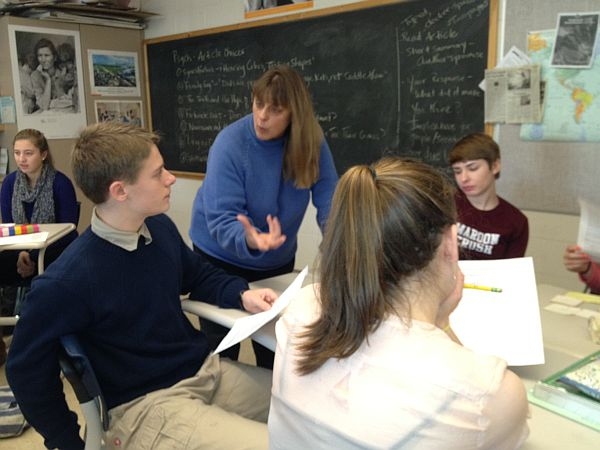
Every year when Thanksgiving rolls around, teachers face a challenge. How do you help students uncover the real story of this holiday in a culturally sensitive way?
At Hanover High School, a class of mostly white students have been learning to see the iconic event from a native American point of view.
At about 8 a.m. Tuesday in Pam Miller’s American history class, sophomores sitting at round tables tried to remember how they were told about the first Thanksgiving in elementary School.
"Basically we followed the story of the Pilgrims, Feltcher Passow remembered. "It was a very Euro-centric, Pilgrim-centric way of looking at things. And it followed them arriving in the new world at Plymouth colony, and pretty much skimmed over how they were trying to survive the first year and then they had the traditional Thanksgiving feast. That was pretty much the synopsis."
Most of the other students were also taught that the first Thanksgiving was a bountiful potluck–a shining example of inter-cultural friendship.
Most say they did not get a native American perspective on that day, or on the decades that followed.
The only surviving first-person account of that first Thanksgiving in English was a 1621 letter by colonist Edward Winslow. It mentions the deer brought by the Wampanoag tribe, names its king, Massasoit, and thanks God-not the tribe–for food badly needed after a failed harvest.
Teacher Pam Miller projected that letter on a screen.
"How do we get from that to a turkey and pies and football?" she wondered aloud.
Emma Malenka thinks Americans don’t like to dwell on hardship, and would rather romanticize their relationship with the natives.
"What actually happened was really grim," she said. " So when you’re teaching that to elementary school kids, they’re… they don’t want to know that it’s actually a grim holiday."
Next, Miller passed out photocopies of articles about Thanksgiving written by native Americans. Some of the native writers call it a National Day of Mourning. Others take a more moderate view.
That shows, Miller explained, that it’s dangerous to make sweeping generalizations about how any single cultural group views the past.
And Miller hopes it’s not only Thanksgiving that makes her students think outside their own cultural box. She tries to weave native American history throughout her lesson plans, all semester long.
That pleases Colin Calloway, the Dartmouth Native American studies professor who gave a seminar Miller took last summer.
"How can we better include Indian people in such a way that that presence, even though it might be a diminishing presence, is recurrent, if not permanent, so that that story is always a part of the larger American story and not relegated to a sidebar in a textbook, " Calloway says teachers should ask.
And Calloway wishes elementary teachers would not dress some kids up as Indians and others as Pilgrims. That only creates stereotypes, he says. He thinks teachers should do what Pam Miller does-give students primary and secondary sources from a wide menu of perspectives, and cook up a lively classroom discussion.